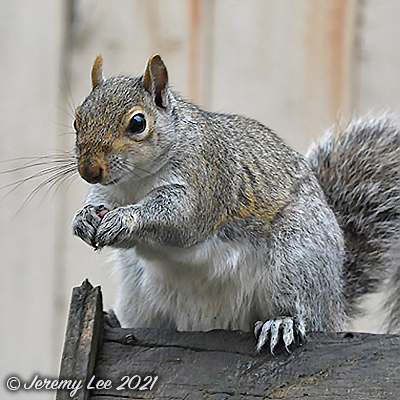
 |
|
Scientific Classifications explained » Amphibians » Ants » Aphids » Bees » Beetles » Birds » Bugs » Butterflies » Caterpillars » Damselflies » Dragonflies » Earwigs » Flies » Frog/Leafhoppers » Fungi » Galls » Grasshoppers » Harvestmen » Hoverflies » Lacewings » Ladybirds » Leaf Mines » Lichens » Mammals » Millipedes » Mosses » Moths » Sawflies » Slugs » Snails » Spiders » Trees & Shrubs » Wasps » Wild Flowers » Woodlice » Postboxes |
UK Nature > Mammals > Sciurus carolinensis

Scientific Name: Sciurus carolinensis Common Name: Grey Squirrel Sciurus carolinensis, otherwise known as the Grey Squirrel, has a head and body measuring 25-30cm, with the tail up to 25cm. Back and tail always grey, although flanks sometimes may have a reddish tinge. White undersides. Eats nuts, especially acorns and hazel nuts; other fruits, buds and young twigs; strips bark to eat nutritious tissue below; also eats insects, birds eggs and nestlings, and regularly 'steals' from bird tables and bird feeders. A serious forest pest, also damaging garden and orchard trees. Diurnal, keeping mainly to the trees. Neatly split hazel nut shells and roughly chewed cones litter feeding sites. Found in mixed woodland, orchards, parks and gardens. A North American animal, introduced to the British Isles late in the 19th century and now common all over England and Wales, where it has largely replaced the native Red Squirrel; less common in Scotland and Ireland. |
|

https://www.uknature.co.uk is a website dedicated to showing the immense diversity of UK nature and wildlife. Our vast range of habitats, from lowland arable to snow covered mountains, from storm-ravaged coastlines to peaceful inland freshwater lakes and rivers, from dry, sandy heaths to deciduous and coniferous forests, all these habitats contribute to the abundance of UK nature. We have wild birds in huge numbers either residing or visiting our shores (597 recorded species as at July 2013) and we must also not forget the humble back garden with its grass lawns, flower beds filled with nectar rich flowers, shrubs and trees, all designed to attract huge numbers of insects such as bees, moths, butterflies and hoverflies; and finally the small ponds which provide safe havens for frogs, toads, newts and even slow worms and grass snakes. www.uknature.co.uk is the showcase for my personal passion, photographing uknature in all its glory. I sincerely hope you all enjoy the fruits of my labours. This site and all images contained therein is © Jeremy Lee 2004 - 2025. All Rights Reserved. Site design by Jeremy Lee. Site development & IT Support by Stuart Lee. |